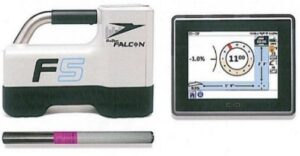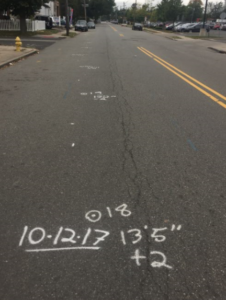Walk-over Locating Systems Ensure Accurate Placement of Horizontal Remediation Wells
At Directional Technologies, we understand accurate placement of horizontal remediation wells (HRWs) within the target cleanup zone is critical to the success of remediation projects. During the HRW installation process, the most common technology applied for verifying HRW depth and position is through use of a walk-over locating system. This locating device is true to its name because the crew member is literally walking right above the drill bit that could be up to 50 feet below ground surface. Walk-over locating systems provides real-time data from the drill bit to the directional drilling team. The system works through transmission of a radio signal from the “beacon” or “sonde” housed within the drill bit to a hand-held receiver at the surface.
Our experienced locators retrieve information regarding the vertical and horizontal position, depth, pitch, and tool-face of the drill-bit. Our team logs the data and uses the information to adjust the direction drilling of the well paths toward the final target locations and depths of the HRWs.

Our field team maintains constant communication to relay real-time location data to our clients to ensure satisfaction of the well path. Additionally, when the horizontal wells are completed, we compile the information into a horizontal well completion report, which provides our clients with professional as-built horizontal well data tables and horizontal well profile diagrams.
Challenges to Accurate Locating
Directional Technologies recognizes that some sites pose challenges to accurate locating of the horizontal well path. Interference from subsurface utilities and other buried objects can alter the transmitted data. Our experienced field team members actively decipher interference encountered during horizontal well installations. Two main types of interference are frequently detected:

- Active interference originates from sources emitting electro-magnetic fields, such as overhead or below ground power lines, two-way radios, tracer wires for subsurface utilities, and cathodic protection lines.
- Passive interference is encountered from sources which are not producing their own electro-magnetic fields, rather they distort, block, or weaken the radio signal from the sonde. The most common source of passive interference is rebar in concrete (source: Digital Control, Inc. 2017).
In addition to active and passive interference, other challenges to accurate locating include surface obstructions above the horizontal well path prohibiting access for the locator.
Obstructions may include inaccessible buildings, above ground storage tanks, high traffic roadways, wetlands, and waterways. A wire-line guidance system is a locating technology appropriate for these scenarios. Wire-line locating enables for direct communication with the drill bit using a communication wire routed through the drill rods; thus, eliminating the need for the walk-over locating system. However, wire-line locating is less time efficient in the field, as it is performed by a third party.
During design of the horizontal remediation well system, Directional Technologies provides clients with the optimal locating strategy best suited to their site and project goals.
Technology Improvements
Directional Technologies is committed to expanding our expertise through investment, proper training, and mastering of the latest technological improvements within our industry, so we can continue to provide our clients with exceptional service and products. Directional Technologies recently invested in the latest walk-over locating system, the DigiTrak F5 and F2 Falcon, which can overcome active and passive interference by transmitting the signal over a wide broadcast range. The walk-over location system can operate in frequency optimization mode enabling the field team to select the most reliable frequency. Additionally, in rebar mode, the locating system will broadcast the signal over 6 bands of frequency improving accuracy in locations with high passive interference.
In addition to frequency modulation technology, battery technology has drastically improved over the last two decades. Improved battery life facilitates drilling of longer wells without the risk of the sonde transmitter losing power.
Regardless of how advanced the technology, experience plays an even more crucial role. Directional Technologies has years of experience installing horizontal remediation well systems for the environmental industry. This experience becomes an invaluable asset for successful installation of a horizontal remediation wells at your site.
Contributing Source: What Causes Interference When Locating A Bore? By Mark Gallucci, Digital Control, Inc. (DCI), November 7, 2017.